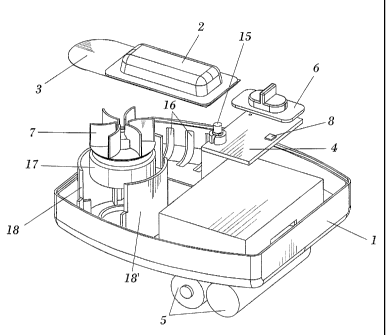Some of the information on this Web page has been provided by external sources. The Government of Canada is not responsible for the accuracy, reliability or currency of the information supplied by external sources. Users wishing to rely upon this information should consult directly with the source of the information. Content provided by external sources is not subject to official languages, privacy and accessibility requirements.
Any discrepancies in the text and image of the Claims and Abstract are due to differing posting times. Text of the Claims and Abstract are posted:
| (12) Patent: | (11) CA 2695481 |
|---|---|
| (54) English Title: | MOTION-SENSING EVAPORATOR DEVICE FOR VOLATILE SUBSTANCES |
| (54) French Title: | DISPOSITIF D'EVAPORATION A DETECTION DE MOUVEMENT POUR SUBSTANCES VOLATILES |
| Status: | Granted |
| (51) International Patent Classification (IPC): |
|
|---|---|
| (72) Inventors : |
|
| (73) Owners : |
|
| (71) Applicants : |
|
| (74) Agent: | SMART & BIGGAR LP |
| (74) Associate agent: | |
| (45) Issued: | 2014-04-01 |
| (86) PCT Filing Date: | 2007-08-24 |
| (87) Open to Public Inspection: | 2009-02-12 |
| Examination requested: | 2012-08-10 |
| Availability of licence: | N/A |
| (25) Language of filing: | English |
| Patent Cooperation Treaty (PCT): | Yes |
|---|---|
| (86) PCT Filing Number: | PCT/EP2007/058816 |
| (87) International Publication Number: | WO2009/018862 |
| (85) National Entry: | 2010-02-03 |
| (30) Application Priority Data: | ||||||
|---|---|---|---|---|---|---|
|
The present invention relates to an evaporator device for volatile substances
preferably for vehicles, which is
acti-vated by means of the movement of the actual device, whereby it is
guaranteed that the device will begin to evaporate the substance
when the user has entered the vehicle. The device comprises a casing (1) and
at least one movement sensor (8) so that means for
diffusion of the substance (7) are operable by means of said sensor.
La présente invention se rapporte à un dispositif d'évaporation pour substances volatiles, adapté pour de préférence des véhicules et activé au moyen du mouvement du dispositif en question, moyennant quoi il est garanti que le dispositif commence à évaporer la substance lorsque l'utilisateur pénètre dans le véhicule. Le dispositif comprend un boîtier (1) et au moins un détecteur de mouvement (8), de sorte que des moyens pour la diffusion de la substance (7) soient commandés au moyen dudit capteur.
Note: Claims are shown in the official language in which they were submitted.
Note: Descriptions are shown in the official language in which they were submitted.

For a clearer understanding of the status of the application/patent presented on this page, the site Disclaimer , as well as the definitions for Patent , Administrative Status , Maintenance Fee and Payment History should be consulted.
| Title | Date |
|---|---|
| Forecasted Issue Date | 2014-04-01 |
| (86) PCT Filing Date | 2007-08-24 |
| (87) PCT Publication Date | 2009-02-12 |
| (85) National Entry | 2010-02-03 |
| Examination Requested | 2012-08-10 |
| (45) Issued | 2014-04-01 |
There is no abandonment history.
Last Payment of $473.65 was received on 2023-07-25
Upcoming maintenance fee amounts
| Description | Date | Amount |
|---|---|---|
| Next Payment if small entity fee | 2024-08-26 | $253.00 |
| Next Payment if standard fee | 2024-08-26 | $624.00 |
Note : If the full payment has not been received on or before the date indicated, a further fee may be required which may be one of the following
Patent fees are adjusted on the 1st of January every year. The amounts above are the current amounts if received by December 31 of the current year.
Please refer to the CIPO
Patent Fees
web page to see all current fee amounts.
| Fee Type | Anniversary Year | Due Date | Amount Paid | Paid Date |
|---|---|---|---|---|
| Application Fee | $400.00 | 2010-02-03 | ||
| Maintenance Fee - Application - New Act | 2 | 2009-08-24 | $100.00 | 2010-02-03 |
| Maintenance Fee - Application - New Act | 3 | 2010-08-24 | $100.00 | 2010-08-04 |
| Maintenance Fee - Application - New Act | 4 | 2011-08-24 | $100.00 | 2011-08-03 |
| Request for Examination | $800.00 | 2012-08-10 | ||
| Maintenance Fee - Application - New Act | 5 | 2012-08-24 | $200.00 | 2012-08-10 |
| Maintenance Fee - Application - New Act | 6 | 2013-08-26 | $200.00 | 2013-07-22 |
| Final Fee | $300.00 | 2014-01-14 | ||
| Maintenance Fee - Patent - New Act | 7 | 2014-08-25 | $200.00 | 2014-08-11 |
| Maintenance Fee - Patent - New Act | 8 | 2015-08-24 | $200.00 | 2015-08-10 |
| Maintenance Fee - Patent - New Act | 9 | 2016-08-24 | $200.00 | 2016-08-16 |
| Maintenance Fee - Patent - New Act | 10 | 2017-08-24 | $250.00 | 2017-08-14 |
| Maintenance Fee - Patent - New Act | 11 | 2018-08-24 | $250.00 | 2018-08-13 |
| Maintenance Fee - Patent - New Act | 12 | 2019-08-26 | $250.00 | 2019-08-06 |
| Maintenance Fee - Patent - New Act | 13 | 2020-08-24 | $250.00 | 2020-08-24 |
| Maintenance Fee - Patent - New Act | 14 | 2021-08-24 | $255.00 | 2021-08-12 |
| Maintenance Fee - Patent - New Act | 15 | 2022-08-24 | $458.08 | 2022-08-12 |
| Maintenance Fee - Patent - New Act | 16 | 2023-08-24 | $473.65 | 2023-07-25 |
Note: Records showing the ownership history in alphabetical order.
| Current Owners on Record |
|---|
| ZOBELE ESPANA, S.A. |
| Past Owners on Record |
|---|
| GARCIA FABREGA, RUBEN |
| GUSI HIDALGO, JOAN |
| MORENO PEREZ, DAVID |
| MUNOZ MARTINEZ, JOSE ANTONIO |